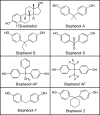Editor's Highlight: Transcriptome Profiling Reveals Bisphenol A Alternatives Activate Estrogen Receptor Alpha in Human Breast Cancer Cells
- PMID: 28591870
- PMCID: PMC5837682
- DOI: 10.1093/toxsci/kfx101
Editor's Highlight: Transcriptome Profiling Reveals Bisphenol A Alternatives Activate Estrogen Receptor Alpha in Human Breast Cancer Cells
Abstract
Plasticizers with estrogenic activity, such as bisphenol A (BPA), have potential adverse health effects in humans. Due to mounting evidence of these health effects, BPA is being phased out and replaced by other bisphenol variants in "BPA-free" products. We have compared estrogenic activity of BPA with 6 bisphenol analogues [bisphenol S (BPS); bisphenol F (BPF); bisphenol AP (BPAP); bisphenol AF (BPAF); bisphenol Z (BPZ); bisphenol B (BPB)] in 3 human breast cancer cell lines. Estrogenicity was assessed (10-11-10-4 M) by cell growth in an estrogen receptor (ER)-mediated cell proliferation assay, and by the induction of estrogen response element-mediated transcription in a luciferase assay. BPAF was the most potent bisphenol, followed by BPB > BPZ ∼ BPA > BPF ∼ BPAP > BPS. The addition of ICI 182,780 antagonized the activation of ERs. Data mining of ToxCast high-throughput screening assays confirm our results but also show divergence in the sensitivities of the assays. Gene expression profiles were determined in MCF-7 cells by microarray analysis. The comparison of transcriptome profile alterations resulting from BPA alternatives with an ERα gene expression biomarker further indicates that all BPA alternatives act as ERα agonists in MCF-7 cells. These results were confirmed by Illumina-based RNA sequencing. In conclusion, BPA alternatives are not necessarily less estrogenic than BPA in human breast cancer cells. BPAF, BPB, and BPZ were more estrogenic than BPA. These findings point to the importance of better understanding the risk of adverse effects from exposure to BPA alternatives, including hormone-dependent breast cancer.
Keywords: bisphenol; cell culture; endocrine; estrogens; toxicogenomics.
© The Author 2017. Published by Oxford University Press on behalf of the Society of Toxicology.
Figures





Comment in
-
Overgeneralization by Mesnage et al. Regarding Bisphenol A Alternatives.Toxicol Sci. 2017 Nov 1;160(1):2. doi: 10.1093/toxsci/kfx167. Toxicol Sci. 2017. PMID: 28973518 No abstract available.
-
No Overgeneralization in Mesnage et al. Regarding Bisphenol A Alternatives: Response.Toxicol Sci. 2017 Nov 1;160(1):3. doi: 10.1093/toxsci/kfx168. Toxicol Sci. 2017. PMID: 28973582 No abstract available.
Similar articles
-
Acute Toxicity, Teratogenic, and Estrogenic Effects of Bisphenol A and Its Alternative Replacements Bisphenol S, Bisphenol F, and Bisphenol AF in Zebrafish Embryo-Larvae.Environ Sci Technol. 2017 Nov 7;51(21):12796-12805. doi: 10.1021/acs.est.7b03283. Epub 2017 Oct 25. Environ Sci Technol. 2017. PMID: 29016128
-
Effects of bisphenol analogues on steroidogenic gene expression and hormone synthesis in H295R cells.Chemosphere. 2016 Mar;147:9-19. doi: 10.1016/j.chemosphere.2015.12.081. Epub 2016 Jan 2. Chemosphere. 2016. PMID: 26751127
-
Bisphenol AF promotes estrogen receptor-positive breast cancer cell proliferation through amphiregulin-mediated crosstalk with receptor tyrosine kinase signaling.PLoS One. 2019 May 6;14(5):e0216469. doi: 10.1371/journal.pone.0216469. eCollection 2019. PLoS One. 2019. PMID: 31059536 Free PMC article.
-
Neuroendocrine disruption in animal models due to exposure to bisphenol A analogues.Front Neuroendocrinol. 2017 Oct;47:123-133. doi: 10.1016/j.yfrne.2017.08.001. Epub 2017 Aug 8. Front Neuroendocrinol. 2017. PMID: 28801100 Free PMC article. Review.
-
A scoping review of the health and toxicological activity of bisphenol A (BPA) structural analogues and functional alternatives.Toxicology. 2019 Aug 1;424:152235. doi: 10.1016/j.tox.2019.06.006. Epub 2019 Jun 12. Toxicology. 2019. PMID: 31201879
Cited by
-
Bisphenols, but not phthalate esters, modulate gene expression in activated human MAIT cells in vitro.Toxicol Rep. 2023 Mar 1;10:348-356. doi: 10.1016/j.toxrep.2023.02.017. eCollection 2023. Toxicol Rep. 2023. PMID: 36923442 Free PMC article.
-
Derivation of a Human In Vivo Benchmark Dose for Bisphenol A from ToxCast In Vitro Concentration Response Data Using a Computational Workflow for Probabilistic Quantitative In Vitro to In Vivo Extrapolation.Front Pharmacol. 2022 Feb 11;12:754408. doi: 10.3389/fphar.2021.754408. eCollection 2021. Front Pharmacol. 2022. PMID: 35222005 Free PMC article.
-
Maternal Bisphenol B Exposure and Mammary Gland Development of Offspring: A Time-Series Analysis.Environ Health (Wash). 2023 Sep 7;1(4):278-290. doi: 10.1021/envhealth.3c00085. eCollection 2023 Oct 20. Environ Health (Wash). 2023. PMID: 39474496 Free PMC article.
-
Overview of the effects of chemical mixtures with endocrine disrupting activity in the context of real-life risk simulation: An integrative approach (Review).World Acad Sci J. 2019 Jul;1(4):157-164. doi: 10.3892/wasj.2019.17. Epub 2019 Aug 5. World Acad Sci J. 2019. PMID: 32346674 Free PMC article.
-
Per- and Polyfluoroalkyl Substances in Food Packaging: Migration, Toxicity, and Management Strategies.Environ Sci Technol. 2024 Apr 2;58(13):5670-5684. doi: 10.1021/acs.est.3c03702. Epub 2024 Mar 19. Environ Sci Technol. 2024. PMID: 38501683 Free PMC article.
References
-
- Ahmed S., Atlas E. (2016). Bisphenol s- and bisphenol a-induced adipogenesis of murine preadipocytes occurs through direct peroxisome proliferator-activated receptor gamma activation. Int. J. Obes. (Lond) 40, 1566–1573. - PubMed
-
- Asimakopoulos A. G., Xue J., De Carvalho B. P., Iyer A., Abualnaja K. O., Yaghmoor S. S., Kumosani T.A., Kannan K. (2015). Urinary biomarkers of exposure to 57 xenobiotics and its association with oxidative stress in a population in Jeddah, Saudi Arabia. Environ. Res. 150, 573–581. - PubMed
-
- Chen D., Kannan K., Tan H., Zheng Z., Feng Y. L., Wu Y., et al. (2016). Bisphenol analogues other than bpa: Environmental occurrence, human exposure, and toxicity-a review. Environ. Sci. Technol. 50, 5438–5453. - PubMed
-
- Dairkee S. H., Seok J., Champion S., Sayeed A., Mindrinos M., Xiao W., et al. (2008). Bisphenol a induces a profile of tumor aggressiveness in high-risk cells from breast cancer patients. Cancer Res. 68, 2076–2080. - PubMed
Publication types
MeSH terms
Substances
LinkOut - more resources
Full Text Sources
Other Literature Sources
Medical
Molecular Biology Databases

